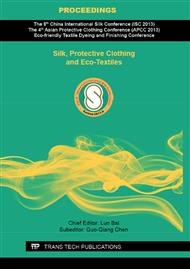p.450
p.454
p.458
p.462
p.468
p.474
p.484
p.488
p.492
The Research on Interesting Area of Bra Style Based on the Eye Tracking Technology
Abstract:
In the background of the societys development, more and more females and designers focused on the consumers requirements. Thus the style which consumers are interested is more important to obtain. Some representative bras are selected in this paper. College students in different ages, genders and majors are chosen to do the eye movement experiments to explore the interesting part of bra from consumers. The interesting areas of bra are shoulder stripe, cup and the bottom. Three important parameters are obtained from the experiment which is the Entry time, Revisits and Dwell time, besides the hot spot diagram is also the key index to reflect the different interested degree in different parts of bra from males and females. On the one hand, it turned out that the concern degree is different in different parts of bra from consumers, the cup is the most part which customers pay more attention, the creative design of shoulder stripe and the bottom of bra will absorb more consumers. On the other hand, it found that the difference is really existed in genders focused on the same bra style, such as the males are focused more on the cup, little attention in other parts, but the females are focused more on shoulder stripe except the cup. The results will not only help the designers to know more about the consumers interesting area of bra, but also can promote the development of the bra which consumers satisfied.
Info:
Periodical:
Pages:
468-473
Citation:
Online since:
September 2013
Authors:
Keywords:
Price:
Сopyright:
© 2013 Trans Tech Publications Ltd. All Rights Reserved
Share:
Citation:


